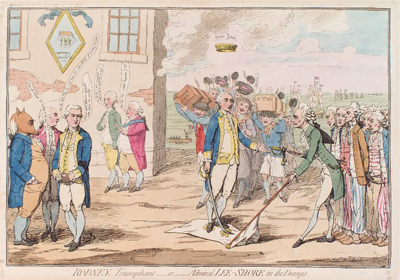Rodney Triumphant, or Admiral Lee Shore in the Dumps
This is one of four prints devoted to Sir George Rodney, the Commander-in Chief of the British naval forces in the West Indies during the American war for independence. They include Rodney Invested, or Admiral Pig on a Cruize. (June 4, 1782), Rodney Introducing De Grasse (June 7,1782) and St. George & the Dragon (June 13,1782). The first two prints to appear were created for Elizabeth D'Archery for whom Gillray worked on 13 prints in 1782 and 1783. The last two were published by Hannah Humphrey.
Rodney Triumphant. . . is both an excellent example of Gillray's transition from emblematic to expressive or dramatic representation of meaning in his visual satires and his superiority in making a complex situation visually accessible by the grouping of his figures.

© National Portrait Gallery, London
The print is divided into two major visual areas. On the right we see a symbolic representation of Admiral George Rodney's naval victory at the Battle of the Saintes, which occurred April 9–12, 1782 near Dominica in the West Indies. On the left we see the political reaction to that victory in London. But there are really two different reactions at home. The reaction of the new Whig Administration is represented by the three figures in the foreground; the reaction of the recently displaced Tories is suggested by the two figures in the background. The "real events" were both temporally and geographically separated. But as in medieval paintings and emblematic prints, because the actions are symbolic representations, they can all occupy the same visual space.
To the applause of the British sailors unloading siezed French treasure*, Rodney is shown at the moment of de Grasse's surrender as the French leader lowers his flag and offers Rodney his sword. DeGrasse is portrayed as a stereotypical Frenchman, painfully thin and foppish, with frogs leaping from his pockets. Behind De Grasse are captured French sailors, looking equally effete. And in the backround one can see a number of captured French vessels with the British flag flying over the French. In reality, it was Admiral Hood who accepted de Grasse's surrender, and it was not on land but on board de Grasse's flagship, the Ville de Paris.
Back in London, the belated news of Rodney's triumph was an embarrassment for the new Whig Administration which had already decided to replace Rodney with Vice-Admiral Hugh Pigot and to replace the Earl of Sandwich with Viscount Augustus Keppel as First Lord of the Admiralty. The new Secretary of State for Foreign Affairs, Charles James Fox, (portrayed with the old emblematic fox's head) exclaims "Dam the French for coming in his way say I". To which the disgruntled Keppel (Admiral Lee Shore) replies "This is more than we expected: more than we wished." The Duke of Richmond (the new Master of the Ordnance) offers what consolation he can: "Tis the last Fleet he shall have the opportunity of beating however." Indeed, as Gillray shows in St George & the Dragon, Rodney was made a Baron and granted a pension of £2000 to blunt the criticism of the new ministry's action and to get Rodney happily off stage.
In the final grouping of the print, the recently deposed Tories in the person of Lord North and the Earl of Sandwich get a certain grim satisfaction from the Whig's discomfiture. Sandwich laughs at the irony of replacing Rodney with Pigot, "Ha! Ha! Ha! - new measures - send a Pig to supercede a Lyon." And North responds with a similar laugh at Keppel's promotion to First Lord of the Admiralty: "Ha! Ha! Ha! behold Augustus ye 27th." He is referring to the Battle of Ushant on April 27, 1778 which Keppel led and in which the British sustained more than three times as many casualties as their French opponents.
Apart from the figures of Fox and de Grasse, most of the identifiable figures can be considered portraits, not caricatures. And indeed Rodney is idealized, looking younger than he appears in Gainsborough's portrait (December 1782), and assuming a classical pose. Gillray had yet to use portrait caricature in a sustained way as he would after 1786.
* According to the Public Advertiser for May 22, 1782, "Twelve Chests of Money were found on board the Ville de Paris for the Subsistence of the French Troops destined for the Descent against Jamaica."
Sources and Reading
- Commentary from the British Museum on Rodney Triumphant, or Admiral Lee Shore in the Dumps
- "George Brydges Rodney, 1st Baron Rodney," Wikipedia
- "François Joseph Paul de Grasse," Wikipedia
- "Battle of the Saintes," Wikipedia
- "Augustus Keppel, 1st Viscount Keppel," Wikipedia
- "Battle of Ushant (1778)," Wikipedia
Comments & Corrections
NOTE: Comments and/or corrections are always appreciated. To make that easier, I have included a form below that you can use. I promise never to share any of the info provided without your express permission.